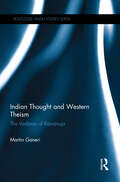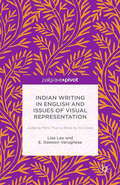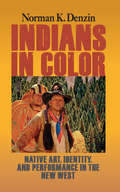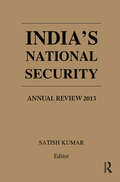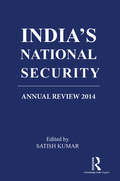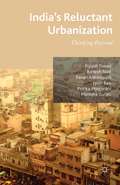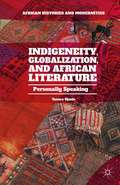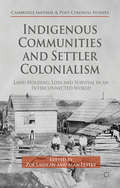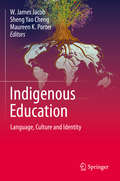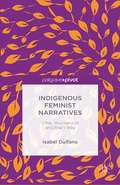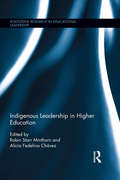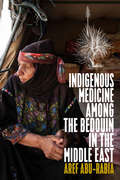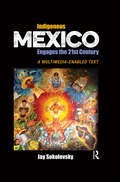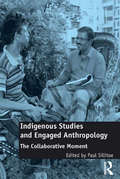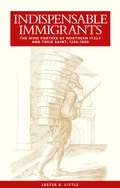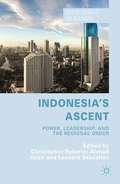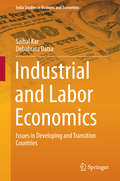- Table View
- List View
Indian Thought and Western Theism: The Vedānta of Rāmānuja (Routledge Hindu Studies Series)
by Martin GaneriThe encounter between the West and India in the modern period has also been an encounter between Western modernity and the traditions of classical Indian thought. This book is the study of one aspect this encounter, that between Western scholasticism and one classical Indian tradition of religious thought and practice: the Vedānta. In the modern period there have been many attempts to relate Western theistic traditions to classical Indian accounts of ultimate reality and the world. Parallels have usually been drawn with modern forms of Western philosophy or modern trends in theism. Modern Indological studies have continued to make substantial use of Western terms and concepts to describe and analyse Indian thought. A much-neglected area of study has been the relationship between Western scholastic theology and classical Indian thought. This book challenges existing parallels with modern philosophy of religion and forms of theism. It argues instead that there is an affinity between scholasticism and classical Indian traditions. It considers the thought of Rāmānuja (traditional dates 1017-1137 CE), who developed an influential theist and realist form of Vedānta, and considers how this relates to that of the most influential of Western scholastics, Thomas Aquinas (1224/5-1274 CE). Within what remain very different traditions we can see similar methods of enquiry, as well as common questions and concerns in their accounts of ultimate reality and of the world. Arguing that there is indeed an affinity between the Western scholastic tradition and that of classical Indian thought, and suggesting a reversal of the tendencies of earlier interpretations, this book will be of interest to students and scholars of Asian religion, Hinduism and Indian philosophy.
Indian Thought and Western Theism: The Vedānta of Rāmānuja (Routledge Hindu Studies Series)
by Martin GaneriThe encounter between the West and India in the modern period has also been an encounter between Western modernity and the traditions of classical Indian thought. This book is the study of one aspect this encounter, that between Western scholasticism and one classical Indian tradition of religious thought and practice: the Vedānta. In the modern period there have been many attempts to relate Western theistic traditions to classical Indian accounts of ultimate reality and the world. Parallels have usually been drawn with modern forms of Western philosophy or modern trends in theism. Modern Indological studies have continued to make substantial use of Western terms and concepts to describe and analyse Indian thought. A much-neglected area of study has been the relationship between Western scholastic theology and classical Indian thought. This book challenges existing parallels with modern philosophy of religion and forms of theism. It argues instead that there is an affinity between scholasticism and classical Indian traditions. It considers the thought of Rāmānuja (traditional dates 1017-1137 CE), who developed an influential theist and realist form of Vedānta, and considers how this relates to that of the most influential of Western scholastics, Thomas Aquinas (1224/5-1274 CE). Within what remain very different traditions we can see similar methods of enquiry, as well as common questions and concerns in their accounts of ultimate reality and of the world. Arguing that there is indeed an affinity between the Western scholastic tradition and that of classical Indian thought, and suggesting a reversal of the tendencies of earlier interpretations, this book will be of interest to students and scholars of Asian religion, Hinduism and Indian philosophy.
Indian Writing in English and Issues of Visual Representation: Judging More than a Book by its Cover
by E. Dawson Varughese Lisa Lau E. Dawson VarugheseThis book examines the use of book covers as marketing devices, asking what exactly they communicate to their readers and buyers, and what images they associate with a genre and create about a culture. Focusing on Indian women's writing in English, it combines the study of text with the study of materiality of the book.
Indians in Color: Native Art, Identity, and Performance in the New West
by Norman K DenzinIn Indians in Color, noted cultural critic Norman K. Denzin addresses the acute differences in the treatment of artwork about Native America created by European-trained artists compared to those by Native artists. In his fourth volume exploring race and culture in the New West, Denzin zeroes in on painting movements in Taos, New Mexico over the past century. Part performance text, part art history, part cultural criticism, part autoethnography, he once again demonstrates the power of visual media to reify or resist racial and cultural stereotypes, moving us toward a more nuanced view of contemporary Native American life. In this book, Denzin-contrasts the aggrandizement by collectors and museums of the art created by the early 20th century Taos Society of Artists under railroad sponsorship with that of indigenous Pueblo painters;-shows how these tensions between mainstream and Native art remains today; and-introduces a radical postmodern artistic aesthetic of contemporary Native artists that challenges notions of the “noble savage.”
Indians in Color: Native Art, Identity, and Performance in the New West
by Norman K DenzinIn Indians in Color, noted cultural critic Norman K. Denzin addresses the acute differences in the treatment of artwork about Native America created by European-trained artists compared to those by Native artists. In his fourth volume exploring race and culture in the New West, Denzin zeroes in on painting movements in Taos, New Mexico over the past century. Part performance text, part art history, part cultural criticism, part autoethnography, he once again demonstrates the power of visual media to reify or resist racial and cultural stereotypes, moving us toward a more nuanced view of contemporary Native American life. In this book, Denzin-contrasts the aggrandizement by collectors and museums of the art created by the early 20th century Taos Society of Artists under railroad sponsorship with that of indigenous Pueblo painters;-shows how these tensions between mainstream and Native art remains today; and-introduces a radical postmodern artistic aesthetic of contemporary Native artists that challenges notions of the “noble savage.”
India's National Security: Annual Review 2013
by Satish KumarIndia’s National Security: Annual Review 2013 comprehensively analyses India’s engagement with major world powers, and immediate neighbours in a complex global security environment. It examines India’s response to internal and external threats, its foreign policy as well as measures taken for strengthening its economic security.
India's National Security: Annual Review 2014
by Satish KumarThis fourteenth volume of India’s National Security Annual Review intensively analyses India’s national security with respect to the changing internal and external dynamics. In the global environment, the situation is characterised by rising tensions between United States and Russia, intensified rivalry between United States (US) and China, and increasing cooperation between China and Russia. For India which seeks peaceful growth to emerge as a major power, this poses severe diplomatic challenges. This volume discusses the complexity of these challenges and the deftness with which India gets the best out of its strategic partnerships with the US and Russia while warding off the transgressions of a mighty adversary like China. It also studies the impact of internal convulsions and external intrusions on India’s security from South Asian nations such as Afghanistan, Bangladesh, Nepal and Sri Lanka. Examining the field of internal security, the essays carry rare insights into the causes of expansion of Naxalite violence in tribal areas and the dynamics of conflict resolution in the Northeast, as well as India’s deep concern as a growing power with its economic slowdown in the recent past, and energy and cyber security. Bringing together contributions from eminent scholars and diplomats, the volume will be indispensable for policymakers, government think tanks, defence and strategic studies experts, as well as students and researchers of international relations, foreign policy and political science.
India's National Security: Annual Review 2014
by Satish KumarThis fourteenth volume of India’s National Security Annual Review intensively analyses India’s national security with respect to the changing internal and external dynamics. In the global environment, the situation is characterised by rising tensions between United States and Russia, intensified rivalry between United States (US) and China, and increasing cooperation between China and Russia. For India which seeks peaceful growth to emerge as a major power, this poses severe diplomatic challenges. This volume discusses the complexity of these challenges and the deftness with which India gets the best out of its strategic partnerships with the US and Russia while warding off the transgressions of a mighty adversary like China. It also studies the impact of internal convulsions and external intrusions on India’s security from South Asian nations such as Afghanistan, Bangladesh, Nepal and Sri Lanka. Examining the field of internal security, the essays carry rare insights into the causes of expansion of Naxalite violence in tribal areas and the dynamics of conflict resolution in the Northeast, as well as India’s deep concern as a growing power with its economic slowdown in the recent past, and energy and cyber security. Bringing together contributions from eminent scholars and diplomats, the volume will be indispensable for policymakers, government think tanks, defence and strategic studies experts, as well as students and researchers of international relations, foreign policy and political science.
India's National Security: Annual Review 2013
by Satish KumarIndia’s National Security: Annual Review 2013 comprehensively analyses India’s engagement with major world powers, and immediate neighbours in a complex global security environment. It examines India’s response to internal and external threats, its foreign policy as well as measures taken for strengthening its economic security.
India's Reluctant Urbanization: Thinking Beyond
by Jyoti Rao P. Tiwari R. Nair P. Ankinapalli M. Gulati P. HingoraniThrough a close examination of India's policies, economic system, social systems and politics, this study explores the numerous perspectives and debates on India's urbanization. The authors link contemporary urban issues with emerging challenges associated with policies and city management.
Indigeneity, Globalization, and African Literature: Personally Speaking (African Histories and Modernities)
by Tanure OjaideLiterature remains one of the few disciplines that reflect the experiences, sensibility, worldview, and living realities of its people. Contemporary African literature captures the African experience in history and politics in a multiplicity of ways. Politics itself has come to intersect and impact on most, if not all, aspects of the African reality. This relationship of literature with African people’s lives and condition forms the setting of this study. Tanure Ojaide’s Indigeneity, Globalization, and African Literature: Personally Speaking belongs with a well-established tradition of personal reflections on literature by African creative writer-critics. Ojaide’s contribution brings to the table the perspective of what is now recognized as a “second generation” writer, a poet, and a concerned citizen of Nigeria’s Niger Delta area.
Indigenous Communities and Settler Colonialism: Land Holding, Loss and Survival in an Interconnected World (Cambridge Imperial and Post-Colonial Studies Series)
by Alan Lester Zoë LaidlawThe new world created through Anglophone emigration in the 19th century has been much studied. But there have been few accounts of what this meant for the Indigenous populations. This book shows that Indigenous communities tenaciously held land in the midst of dispossession, whilst becoming interconnected through their struggles to do so.
Indigenous Education: Language, Culture and Identity
by W. James Jacob Sheng Yao Cheng Maureen K. PorterIndigenous Education is a compilation of conceptual chapters and national case studies that includes empirical research based on a series of data collection methods. The book provides up-to-date scholarly research on global trends on three issues of paramount importance with indigenous education—language, culture, and identity. It also offers a strategic comparative and international education policy statement on recent shifts in indigenous education, and new approaches to explore, develop, and improve comparative education and policy research globally. Contributing authors examine several social justice issues related to indigenous education. In addition to case perspectives from 12 countries and global regions, the volume includes five conceptual chapters on topics that influence indigenous education, including policy debates, the media, the united nations, formal and informal education systems, and higher education.
Indigenous Feminist Narratives: I/We: Wo(men) of an(Other) Way
by Isabel Dulfano I. DUlfanoThis book analyzes the literary representation of Indigenous women in Latin American letters from colonization to the twentieth century, arguing that contemporary theorization of Indigenous feminism deconstructs denigratory imagery and offers a (re)signification, (re)semantization and reinvigoration of what it means to be an Indigenous woman.
Indigenous Leadership in Higher Education (Routledge Research in Educational Leadership)
by Robin Starr Minthorn Alicia Fedelina ChávezThis volume offers new perspectives from Indigenous leaders in academic affairs, student affairs and central administration to improve colleges and universities in service to Indigenous students and professionals. It discusses and illustrates ways that leadership norms, values, assumptions and behaviors can often find their origins in cultural identities, and how such assumptions can affect the evolvement of colleges and universities in serving Indigenous Peoples. It contributes to leadership development and reflection among novice, experienced, and emerging leaders in higher education and provides key recommendations for transforming higher education. This book introduces readers to relationships between Indigenous identities and leadership in diverse educational environments and institutions and will benefit policy makers in education, student affairs professionals, scholars, faculty and students.
Indigenous Leadership in Higher Education (Routledge Research in Educational Leadership)
by Robin Minthorn Alicia Fedelina ChavezThis volume offers new perspectives from Indigenous leaders in academic affairs, student affairs and central administration to improve colleges and universities in service to Indigenous students and professionals. It discusses and illustrates ways that leadership norms, values, assumptions and behaviors can often find their origins in cultural identities, and how such assumptions can affect the evolvement of colleges and universities in serving Indigenous Peoples. It contributes to leadership development and reflection among novice, experienced, and emerging leaders in higher education and provides key recommendations for transforming higher education. This book introduces readers to relationships between Indigenous identities and leadership in diverse educational environments and institutions and will benefit policy makers in education, student affairs professionals, scholars, faculty and students.
Indigenous Medicine Among the Bedouin in the Middle East
by Aref Abu-RabiaModern medicine has penetrated Bedouin tribes in the course of rapid urbanization and education, but when serious illnesses strike, particularly in the case of incurable diseases, even educated people turn to traditional medicine for a remedy. Over the course of 30 years, the author gathered data on traditional Bedouin medicine among pastoral-nomadic, semi-nomadic, and settled tribes. Based on interviews with healers, clients, and other active participants in treatments, this book will contribute to renewed thinking about a synthesis between traditional and modern medicine — to their reciprocal enrichment.
Indigenous Mexico Engages the 21st Century: A Multimedia-enabled Text
by Jay SokolovskyThis innovative, interactive ethnography employs a range of media to explore the lives of the residents of a village set in the rugged mountains overlooking Mexico City, focusing on how these villagers react and adapt to a rapidly globalized world. Students can view the evolving life of San Jerónimo Amanalco and its region over the past four decades through print, web-embedded, and e-reader enabled resources. This book-offers a multimedia approach, including archival images and documents, original photographs, audio recordings, and extensive video;-incorporates ethnographic information gathered during the author’s four decades of research in the region;-includes community members’ responses to the author’s research through social media, email, and video-taped comments.
Indigenous Mexico Engages the 21st Century: A Multimedia-enabled Text
by Jay SokolovskyThis innovative, interactive ethnography employs a range of media to explore the lives of the residents of a village set in the rugged mountains overlooking Mexico City, focusing on how these villagers react and adapt to a rapidly globalized world. Students can view the evolving life of San Jerónimo Amanalco and its region over the past four decades through print, web-embedded, and e-reader enabled resources. This book-offers a multimedia approach, including archival images and documents, original photographs, audio recordings, and extensive video;-incorporates ethnographic information gathered during the author’s four decades of research in the region;-includes community members’ responses to the author’s research through social media, email, and video-taped comments.
Indigenous Studies and Engaged Anthropology: The Collaborative Moment
by Paul SillitoeAdvancing the rising field of engaged or participatory anthropology that is emerging at the same time as increased opposition from Indigenous peoples to research, this book offers critical reflections on research approaches to-date. The engaged approach seeks to change the researcher-researched relationship fundamentally, to make methods more appropriate and beneficial to communities by involving them as participants in the entire process from choice of research topic onwards. The aim is not only to change power relationships, but also engage with non-academic audiences. The advancement of such an egalitarian and inclusive approach to research can provoke strong opposition. Some argue that it threatens academic rigour and worry about the undermining of disciplinary authority. Others point to the difficulties of establishing an appropriately non-ethnocentric moral stance and navigating the complex problems communities face. Drawing on the experiences of Indigenous scholars, anthropologists and development professionals acquainted with a range of cultures, this book furthers our understanding of pressing issues such as interpretation, transmission and ownership of Indigenous knowledge, and appropriate ways to represent and communicate it. All the contributors recognise the plurality of knowledge and incorporate perspectives that derive, at least in part, from other ways of being in the world.
Indigenous Studies and Engaged Anthropology: The Collaborative Moment
by Paul SillitoeAdvancing the rising field of engaged or participatory anthropology that is emerging at the same time as increased opposition from Indigenous peoples to research, this book offers critical reflections on research approaches to-date. The engaged approach seeks to change the researcher-researched relationship fundamentally, to make methods more appropriate and beneficial to communities by involving them as participants in the entire process from choice of research topic onwards. The aim is not only to change power relationships, but also engage with non-academic audiences. The advancement of such an egalitarian and inclusive approach to research can provoke strong opposition. Some argue that it threatens academic rigour and worry about the undermining of disciplinary authority. Others point to the difficulties of establishing an appropriately non-ethnocentric moral stance and navigating the complex problems communities face. Drawing on the experiences of Indigenous scholars, anthropologists and development professionals acquainted with a range of cultures, this book furthers our understanding of pressing issues such as interpretation, transmission and ownership of Indigenous knowledge, and appropriate ways to represent and communicate it. All the contributors recognise the plurality of knowledge and incorporate perspectives that derive, at least in part, from other ways of being in the world.
Indispensable immigrants: The wine porters of Northern Italy and their saint, 1200–1800
by Lester LittleIndispensable immigrants recreates the world of peasants who streamed into the cities of late medieval and early modern northern Italy to carry crushingly heavy containers of wine. Written in an easily accessible and unassuming style, it is solidly grounded in previously untapped archival and visual sources. In this first-ever reconstruction of the forgotten metier of wine porter, topography plays a key role in forming the labour market; in the scramble to distinguish professionals from manual labourers the term artist gets divorced from lowly artisan, and wretched diet is invoked to explain why workers are so unintelligent; the wine porters make one of their own their patron saint in thirteenth-century Cremona and other interest groups scheme successfully to get him canonised in Rome five centuries later; and when enlightened despots abolish the guilds, the wine porters’ trade fades away just as the candles on their patron’s altars sputter and die out.
Indispensable immigrants: The wine porters of Northern Italy and their saint, 1200–1800
by Lester LittleIndispensable immigrants recreates the world of peasants who streamed into the cities of late medieval and early modern northern Italy to carry crushingly heavy containers of wine. Written in an easily accessible and unassuming style, it is solidly grounded in previously untapped archival and visual sources. In this first-ever reconstruction of the forgotten metier of wine porter, topography plays a key role in forming the labour market; in the scramble to distinguish professionals from manual labourers the term artist gets divorced from lowly artisan, and wretched diet is invoked to explain why workers are so unintelligent; the wine porters make one of their own their patron saint in thirteenth-century Cremona and other interest groups scheme successfully to get him canonised in Rome five centuries later; and when enlightened despots abolish the guilds, the wine porters’ trade fades away just as the candles on their patron’s altars sputter and die out.
Indonesia's Ascent: Power, Leadership, and the Regional Order (Critical Studies of the Asia-Pacific)
by Christopher B. Roberts Ahmad D. Habir Leonard C. SebastianThis volume explores the domestic and transnational considerations associated with Indonesia's ascent, referring to its rise in terms of hard and soft power and its likely trajectory in the future. The range of contributors analyse economic resources, religious harmony, security, regional relations, leadership and foreign policy.
Industrial and Labor Economics: Issues in Developing and Transition Countries (India Studies in Business and Economics #25)
by Saibal Kar Debabrata DattaThis book is an attempt to capture and analyze several idiosyncratic features of industry and labor in the developing world. Available books and graduate-level texts in labor economics largely discuss industrial and labor market situations prevalent in developed countries, where well-defined institutional arrangements and regulations create a very different scope of analysis. The patterns of choice in training and contracts in the labor market more apparent in developing and transition countries are discussed, as are the information-theoretic results. The book also critically examines labor migration, a context in which the developing and transition countries represent large sources in the present global order. A broad base of empirical observations from industries is used to develop analytical conjectures on risk-sharing arrangements between workers and employers, while strong intuitive explanations are combined with relevant mathematical and graphical derivations, ensuring the book’s readability among graduate students pursuing courses in labor economics and industrial economics for developing and transition countries. The book may also serve as a valuable reference guide for all students in advanced human resources courses at management schools. Presenting state-of-the art research findings in all of its chapters, the book discusses numerous institutional peculiarities of the developing world, making the results distinct in view of the general scope of labor economics.
